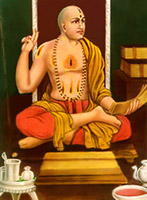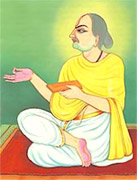The Vedanta philosophy is important both for its philosophical views and its close connections with the existing Hinduism. Vedantists do not accept multiple Purusha. Reality is one as Brahman and the rest of the universe including mind and its modifications are but a superimposition upon this one Reality. The word Vedanta is a compound of Veda which means "knowledge" and anta means "end or conclusion". It is also called the Uttara Mimamsa. The man, who is revered as the head of the Vedantic school, was Badarayuna, or Vyas.
Vedanta can be put as:
 a) Absolute Monism of Shankara or Advaita: Shankara maintains that there exists but One Reality as Brahman whose nature is pure Consciousness. Shankara discusses the question of reality of individual soul, this world, and Ishvara from this point of view and labels them as illusory. Final Liberation comes when this knowledge of unity of individual soul and eternal Soul is established through meditation and Samadhi.
a) Absolute Monism of Shankara or Advaita: Shankara maintains that there exists but One Reality as Brahman whose nature is pure Consciousness. Shankara discusses the question of reality of individual soul, this world, and Ishvara from this point of view and labels them as illusory. Final Liberation comes when this knowledge of unity of individual soul and eternal Soul is established through meditation and Samadhi.
b) Vishishta Advaita or qualified monism of Ramanuja: Ramanuja is the founder of Vishishta-Advaita Vedanta. This is a philosophy of religion; and therefore it gives a synthetic view of the spiritual experiences of God or Brahman. It affirms the Upanishadic truth by realizing Brahman everything else is realized. Heavily depending upon theory of Karma, this philosophy applies the law of cause and effect to moral experiences.
Sub-schools of Vedanta:
Advaita: This is one of the dominant sub-schools of the Vedanta theory. Advaita literally means non-dualism and is based on the Upanishads, Brahma Sutra and Bhagavad Gita. The word "Advaita" essentially refers to the identity of the Self (Atman) and the Whole (Brahman).
Ramanuja`s Visishtadvaita: This is a non-dualistic sub-school of Vedanta. VishishtAdvaita is characterised by multiplicity. Ramanuja, the founder, maintained that God himself is composed of parts; individual souls and physical world comprise the body of God. Ramanuja unified a personal theist god with the single universal god of monism. This unification made the system popular among the common folk. Ramanuja proposed that the Upanishads, Bhagavad Gita, and Brahma Sutras are to be interpreted in way that shows this unity in diversity.
 Madhvacharya`s Dvaita: It is also known as Tattva Vada and Bheda-Vada. It was founded by Madhvacharya. It stresses on a strict distinction between God and the individual living beings. According to Madhva charya, souls depend on God for their existence. God is seen as the cause of this universe and not of the material world. The Dvaita doctrine was summarized by Vyasa Tirtha as comprising nine tenets or Prameyas. According to Madhva Charya, life in this entire universe can be divided into two groups Kshara and Akshara. Kshara has life with destructible bodies while Akshara have indestructible bodies. Laxmi is Akshara while others from Brahma and so on are Ksharas or Jeevas.
Madhvacharya`s Dvaita: It is also known as Tattva Vada and Bheda-Vada. It was founded by Madhvacharya. It stresses on a strict distinction between God and the individual living beings. According to Madhva charya, souls depend on God for their existence. God is seen as the cause of this universe and not of the material world. The Dvaita doctrine was summarized by Vyasa Tirtha as comprising nine tenets or Prameyas. According to Madhva Charya, life in this entire universe can be divided into two groups Kshara and Akshara. Kshara has life with destructible bodies while Akshara have indestructible bodies. Laxmi is Akshara while others from Brahma and so on are Ksharas or Jeevas.
Dvaitadvaita: The originator of this philosophy was Nimbarka, a 13th Century Vaishnava Philosopher. He believed in three categories of existence which are similar to Vishisht Advaita. These are the Chit, Achit and Isvara. Boht Chit and Achit have attributes (Guna) and capacities (Swabhaava), which are different from those of Isvara, who is the God, is independent and exists all by himself. Chit and Achit, both depend on Isvara. Therefore Isvara has independent existence and Chit and Achit have a dependent existence.
 Vallabhacharya`s Shuddhadvaita: According to Vallabhacharya, the founder of the Vallabha sect in the Indian Philosophy, the glorious Krishna in his "Sacchidananda" form is the Absolute Brahman. Lord Krishna is believed to be permanently playing out his sport or Leela, from his seat. This is beyond the divine Vaikuntha, the abode of Lord Vishnu and Satya-loka, the abode of Lord Brahma the Creator, and Kailas, the abode of Lord Shiva.
Vallabhacharya`s Shuddhadvaita: According to Vallabhacharya, the founder of the Vallabha sect in the Indian Philosophy, the glorious Krishna in his "Sacchidananda" form is the Absolute Brahman. Lord Krishna is believed to be permanently playing out his sport or Leela, from his seat. This is beyond the divine Vaikuntha, the abode of Lord Vishnu and Satya-loka, the abode of Lord Brahma the Creator, and Kailas, the abode of Lord Shiva.
Eight disciples of Vallabhacharya are called the ashta-chaap (eight reprints). Bhakti is the only path to obtain this bliss of Lord Krishna. Pushti Bhakti is recommended in this age and this path is called the `pushti maarg`.
Chaitanya Mahaprabhu`s Achintya Bheda Abheda: Chaitanya Mahaprabhu (1486-1534), was a devotee of Lord Krishna. He was an ascetic Vaishnava monk and social reformer in 16th century Bengal. He proposed a synthesis between the monist and dualist philosophies by stating that the soul is both distinct and non-distinct from God. He identified this soul with Lord Krishna. He said that this philosophy maybe experienced through a process of loving devotion. A Vedantist adopts the cosmogony of the Sankhyas in its main features.



















